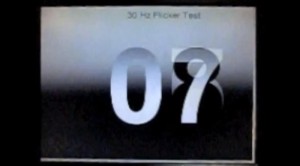nefrusy wrote:For example, the fastest average GtG measured at TFTCentral for an IPS was 8.3ms (without severe overshoot). If that's the case, then wouldn't running such a display at 120Hz be moot? 1/120 = 8.33 ms, so essentially each frame the pixels would be in constant transition. Maybe the persistence is decreased, but it seems like the slow GtG would introduce its own blur?
We need a moment where the whole screen is completed transition, which means we need pixel response that fits inside the time period of a vertical blanking interval.
That's how all the strobed TN monitors work; they try to complete GtG inside a blanking interval (akin to that black bar in the rolling-VHOLD analog television days), so that the entire screen is all fully refreshed all at once. Vertical blanking intervals of a typical 1080p signal is only 0.5ms, while the techniques used by LightBoost (or manual Vertical Total tweaks), lengthen the blanking interval to between 2ms-4ms -- meaning out of 8.3ms, about 4-6ms is spent scanning the LCD screen from top-edge-to-bottom-edge. Then we need to wait for all pixels to finish GtG transition. Then the backlight is strobed on a fully-refreshed frame.
Here's high speed videos of the
TestUFO Flicker Test (
Warning to epileptics; don't click)
High Speed Video of Slow LCD GtG
-- bad for strobed blur reduction
High Speed Video of FAST LCD GtG
-- good for strobed blur reduction
Oh, and when an LCD is in perpetual transition, multiple frames can overlap (frames 06, 07 and 08):

But even when an LCD is fast enough, you may still have a situation where two frames, SOMEWHERE, on the screen is overlapping. You want the 'transition' to be hidden off the top/bottom edge of the screen, inside the blanking interval -- the pause between refresh cycles. The vertical blanking interval is below the bottom edge of the screen (of previous refresh) and above the top edge of the screen (of subsequent refresh). The longer the vertical blanking interval, the more GtG pixel settlement time, so that all pixels on the whole screen is simultaneously fully refreshed (as much to completion as possible) before the backlight is strobed.
A 6ms GtG screen is too slow for clean 120Hz strobing.
Even a 3ms GtG screen is too slow for clean 120Hz strobing; as real-world GtG is often 6ms.
You really want 1ms GtG, to have most (>99%) of real-world GtG complete inside a vertical blanking interval (the time not spent scanning the screen) -- a tiny fraction of an LCD refresh cycle.
Unfortunately, IPS will need lots of work to be cleanly strobeable at 120Hz, though it should now be quite adequate at ~75Hz (hopefully one of the manufacturers, such as BENQ, will be daring enough to enable strobing -- but there will be far more strobe crosstalk than on a TN panel at the same refresh rate).
